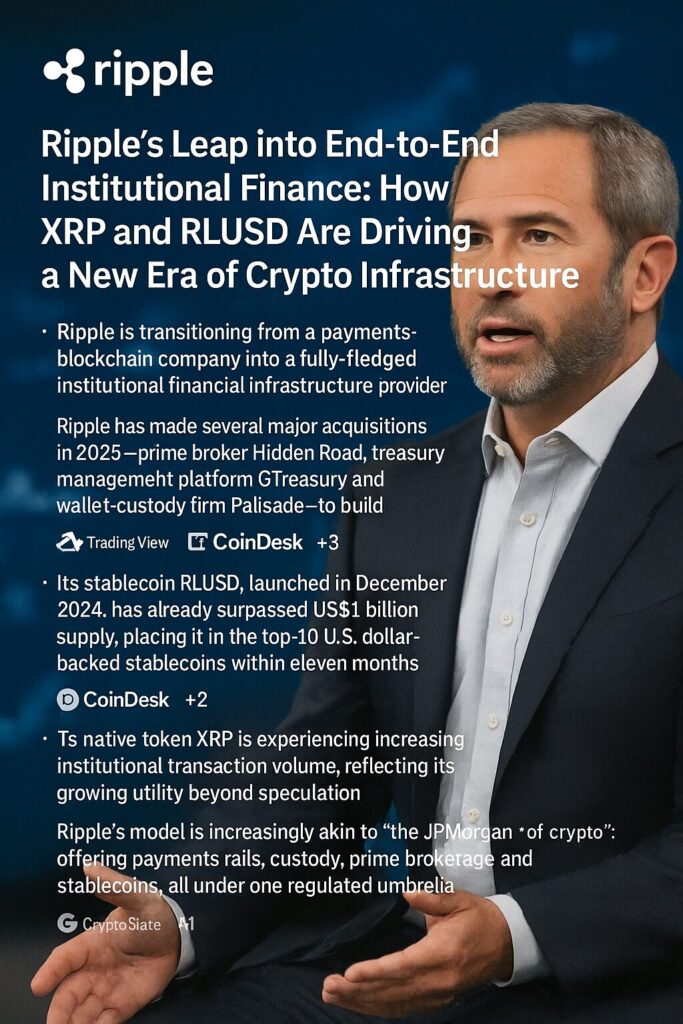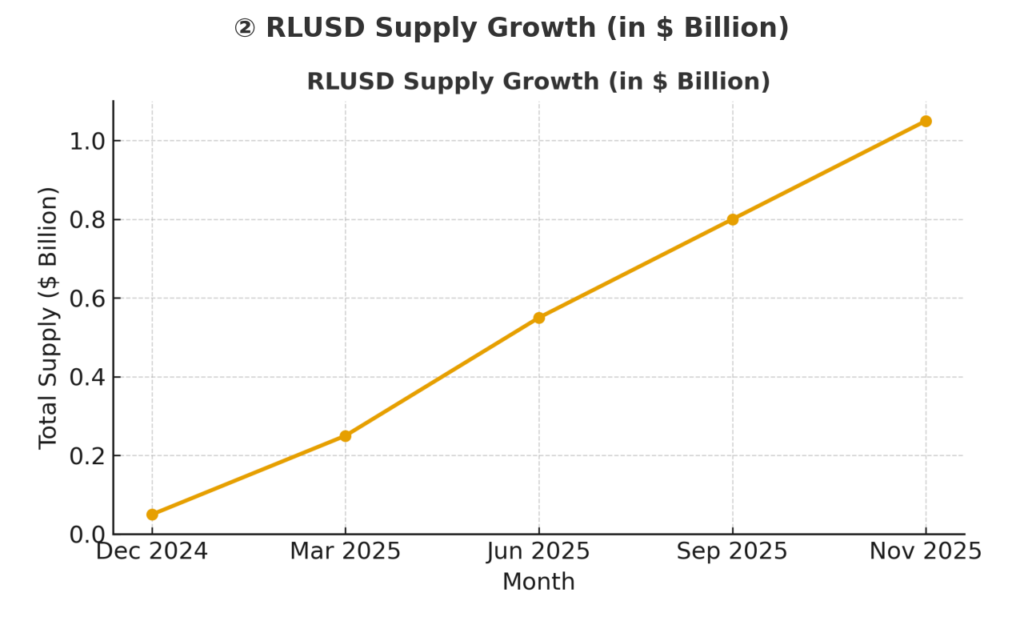
Key Points :
- Ripple (Ripple) is transitioning from a payments-blockchain company into a fully-fledged institutional financial infrastructure provider.
- Ripple has made several major acquisitions in 2025—prime broker Hidden Road, treasury management platform GTreasury and wallet-custody firm Palisade—to build an integrated backend for payments, custody and trading.
- Its stablecoin RLUSD, launched in December 2024, has already surpassed a US$1 billion supply, placing it in the top-10 U.S. dollar-backed stablecoins within eleven months.
- The native token XRP is experiencing increasing institutional transaction volume, reflecting its growing utility beyond speculation.
- Ripple’s model is increasingly akin to “the JPMorgan of crypto”: offering payments rails, custody, prime brokerage and stablecoins, all under one regulated umbrella.
- For crypto investors and practitioners seeking new assets or blockchain-applications, this builds a compelling narrative: tokens and platforms with real-world institutional traction (rather than purely retail hype) may merit closer attention.
1. Evolution of Ripple – From blockchain payments to full-stack financial services
Since its early years as a blockchain payments firm, Ripple has shifted gears to become a full-blown financial infrastructure provider targeting institutional clients. Rather than simply facilitating cross-border remittance or token transfers, the company is now vertically integrating the “rails” of finance: payments, custody, settlement, brokerage and liquidity management.
In 2025 alone, Ripple acquired Hidden Road (a prime broker) for about US$1.25 billion. It also acquired GTreasury, which provides corporate-treasury technology, and recently Palisade, a wallet-as-a-service and custody specialist. These moves show Ripple’s ambition to own the full stack—from high-frequency trading clients down to frontier payment flows.
Moreover, Ripple now boasts over 75 regulatory licences globally (as stated by its president), indicating that the firm is serious about compliance-ready infrastructure, not just crypto hype.
For blockchain practitioners and investors, the implication is clear: utility and institutional adoption—not just token price headlines—are key. Projects with demonstrable enterprise traction may have staying power.

2. RLUSD: The Stablecoin Anchor of the Ecosystem
A notable pillar of Ripple’s strategy is its own U.S.-dollar-backed stablecoin, RLUSD. Launched in December 2024, RLUSD has already broken through the US$1 billion supply mark, making it the 10th largest U.S. dollar-stablecoin by market cap in under a year. According to data, about 80 % of the RLUSD supply sits on Ethereum and roughly 20 % on the XRP Ledger.
Ripple markets RLUSD as the core settlement medium across its infrastructure: payments flows, cross-border settlement, institutional treasury operations and so on. In an interview, Ripple’s president noted: “We’ve doubled the number of customers throughout the year… RLUSD is the primary stablecoin used for payment flows.”
From a practitioner’s vantage: A stablecoin with institutional backing, compliance readiness and dual-chain architecture (Ethereum + XRPL) is a different class of token than many retail-oriented projects. For those seeking “next-gen” crypto assets or opportunities, RLUSD (and projects like it) merit attention.

3. XRP’s Role: Beyond Speculation into Settlement and Liquidity
While much of the media spotlight focuses on XRP’s price, the deeper story is how XRP is being used. Analysts suggest that the increased transaction volumes reflected this year mark a shift from speculative volume to settlement-volume linked to institutional use cases.
In other words: XRP is beginning to operate not just as a token for speculation but as a utility asset within Ripple’s infrastructure, serving settlement, liquidity-bridging or hedging functions. For blockchain developers building on XRPL or related systems, this means real flows (not just test flows) are increasingly happening.
If you are evaluating crypto assets or building applications, aligning with networks that have a growing institutional settlement function (like XRPL + XRP) can be a differentiator.

4. The Institutional Infrastructure Stack Explained
Ripple is essentially constructing an institutional-grade stack with the following pillars:
- Payments & settlement rails: via Ripple Payments, leveraging RLUSD and XRP.
- Custody & wallet infrastructure: via Palisade’s wallet “as a service” + Ripple Custody.
- Prime brokerage / trading infrastructure: via Hidden Road (renamed Ripple Prime) enabling multi-asset trading, clearing and collateral utilisation of RLUSD.
- Treasury/asset-management interface: via GTreasury, enabling corporates to manage cash, liquidity, tokenised assets and more.
- Stablecoin backbone: RLUSD providing a compliant, regulated settlement medium.
- Native token utility: XRP providing transaction settlement, bridging, and institutional-grade flows.
This full-stack model gives Ripple an edge: owning the rails, the coin, the custody, the settlement. As one analysis puts it, the company is building a “walled garden” model of institutional finance akin to big tech’s vertical integration.
For someone designing blockchain applications—such as your interest in non-custodial wallet development and institutional use cases—this is highly relevant: it signals increasing demand for systems that integrate custody, settlement, trading and compliance. It also suggests potential interoperability targets (XRPL + Ethereum + possibly Solana) as multi-chain support becomes a requirement.
5. Implications for Investors, Developers and Blockchain Practitioners
For investors and those hunting new crypto assets:
- Look for tokens and ecosystems that are beginning to see institutional adoption, regulatory readiness and real usage (not just speculative hype). Ripple’s model is one example.
- Stablecoins issued by regulated entities with institutional use cases (e.g., RLUSD) may become more attractive as settlement layers rather than purely “parking” assets.
- Tokens (like XRP) linked to infrastructure usage rather than purely speculation may have differentiated risk/return profiles.
For developers, wallet builders, non-custodial platforms:
- Ripple’s acquisition of Palisade and emphasis on wallet-as-a-service suggests institutional demand for high-throughput, high-frequency wallet flows (on- and off-ramps, subscription payments, corporate payments) across multiple chains.
- If you’re working with wallets or swaps (your interest in BTC→ETH swaps, non-custodial UX), the trend toward regulated custody + liquidity + settlement infrastructure is relevant: bridging non-custodial UX with institutional settlement rails is going to be a differentiator.
- The dual-chain architecture of RLUSD (Ethereum + XRPL) underscores the importance of multi-chain support (and EVM compatibility) for future wallet/trading infrastructure.
For institutional audiences or enterprises exploring blockchain integration:
- Ripple’s stack shows one path: integrate payments, custody, settlement and treasury via a regulated provider under one umbrella.
- The trend of stablecoins being embedded in treasury operations (corporate cash management, cross-border flows) is gaining traction. RLUSD’s rapid rise suggests corporates are not only pilots but live flows.
- Regulators are increasingly in focus. Ripple is applying for U.S. national bank charter, seeking Fed master account access—this signals that compliance and regulator alignment are no longer optional for institutional blockchain infrastructure.
6. Recent Developments & What to Watch
Acquisition pace & investment size:
Ripple’s 2025 acquisition spree brings its investment total to roughly US$4 billion, including Palisade, Hidden Road, GTreasury and others. This scale signals that institutional crypto infrastructure is no longer niche—it’s scaling up.
Stablecoin growth:
RLUSD’s supply growth is extraordinary: more than 1,000 % year-to-date, reaching ~US$1.02 billion within eleven months of launch. This rapid growth suggests a strong institutional appetite for a regulated settlement stablecoin tied to a full-stack provider.
Regulatory alignment:
Ripple’s strategy of securing licences, aiming for a national bank charter and aligning stablecoin issuance with regulated entities shows that regulatory risk is being addressed head-on. For blockchain integrators and enterprises, this reduces counterparty, compliance and regulatory risk.
Token utility and adoption:
XRP usage is shifting. Rather than simply being traded, it’s increasingly used for settlement and institutional flows. Analysts note transaction volumes at multi-year highs, hinting at true utility adoption rather than mere speculation.
What to track going forward:
- RLUSD’s growth trajectory: whether supply jumps to US$5 billion+ and whether real flows (cross-border, treasury) are reported.
- XRP ledger usage metrics: transaction volume, number of corporate flows, settlement size.
- Regulatory approvals: whether Ripple attains U.S. national bank charter or Federal Reserve master account.
- Integration of Ripple’s stack with new corporate clients, banks, global treasury operations.
- Interoperability: whether RLUSD and XRP usage expands beyond XRPL + Ethereum into wider DeFi or tokenised asset rails.
7. Why This Matters for the Two-Extremes Model in Blockchain
You’ve mentioned your “Two-Extremes Model” concept (Asset-Backed Representation vs Autonomous Trust Tender). Ripple’s approach touches both ends of that spectrum:
- On the Asset-Backed Representation side, RLUSD is a dollar-backed stablecoin integrated into corporate treasuries, prime brokerage and regulated flows.
- On the Autonomous Trust Tender side, XRP and XRPL provide blockchain-native settlement, cross-chain transfer and decentralised flows.
- The integration of both rails (regulated stablecoin + native ledger + custody + trading) reflects a bridging of the two extremes: value representation (dollars, assets) and autonomous trust (blockchain rails, decentralised settlement).
- For your wallet development (BTC→ETH swaps, UX transparency), seeing a provider like Ripple build end-to-end infrastructure shows a viable path for integrating non-custodial UX with institutional rails and settlement flows. This may inform your architecture: you’ll need to handle liquidity, settlement, compliance, cross-chain flows and transparency in your design.
8. Conclusion
In sum, Ripple’s evolution from a payments-focused blockchain firm into a full-stack institutional infrastructure provider is a significant development for the crypto ecosystem—and one worth monitoring for investors, developers and enterprise adopters alike. The rapid rise of RLUSD as a regulated stablecoin, the increased utility of XRP, and the acquisitions that build payments, custody and brokerage rails all underscore a shift: blockchain infrastructure is entering the mainstream of institutional finance.
For those seeking new crypto assets, innovative blockchain applications or enterprise blockchain use cases, the takeaway is clear: Projects that combine real-world flows, regulation-ready infrastructure and token/settlement utility are emerging winners. Simply having a token with hype may no longer be enough. The future belongs to platforms that deliver end-to-end functionality.
As you develop your non-custodial wallet and explore BTC→ETH swaps, keep in mind the bigger landscape: liquidity, settlement rails, regulatory compliance and multi-chain interoperability. The components Ripple is assembling provide a template for what “institutional-grade crypto infrastructure” looks like—and perhaps for what your architecture should support.

